A Nanoporous Supramolecular Metal–Organic Framework Based on a Nucleotide: Interplay of the π···π Interactions Directing Assembly and Geometric Matching of Aromatic Tails
Abstract
:1. Introduction
2. Results and Discussions
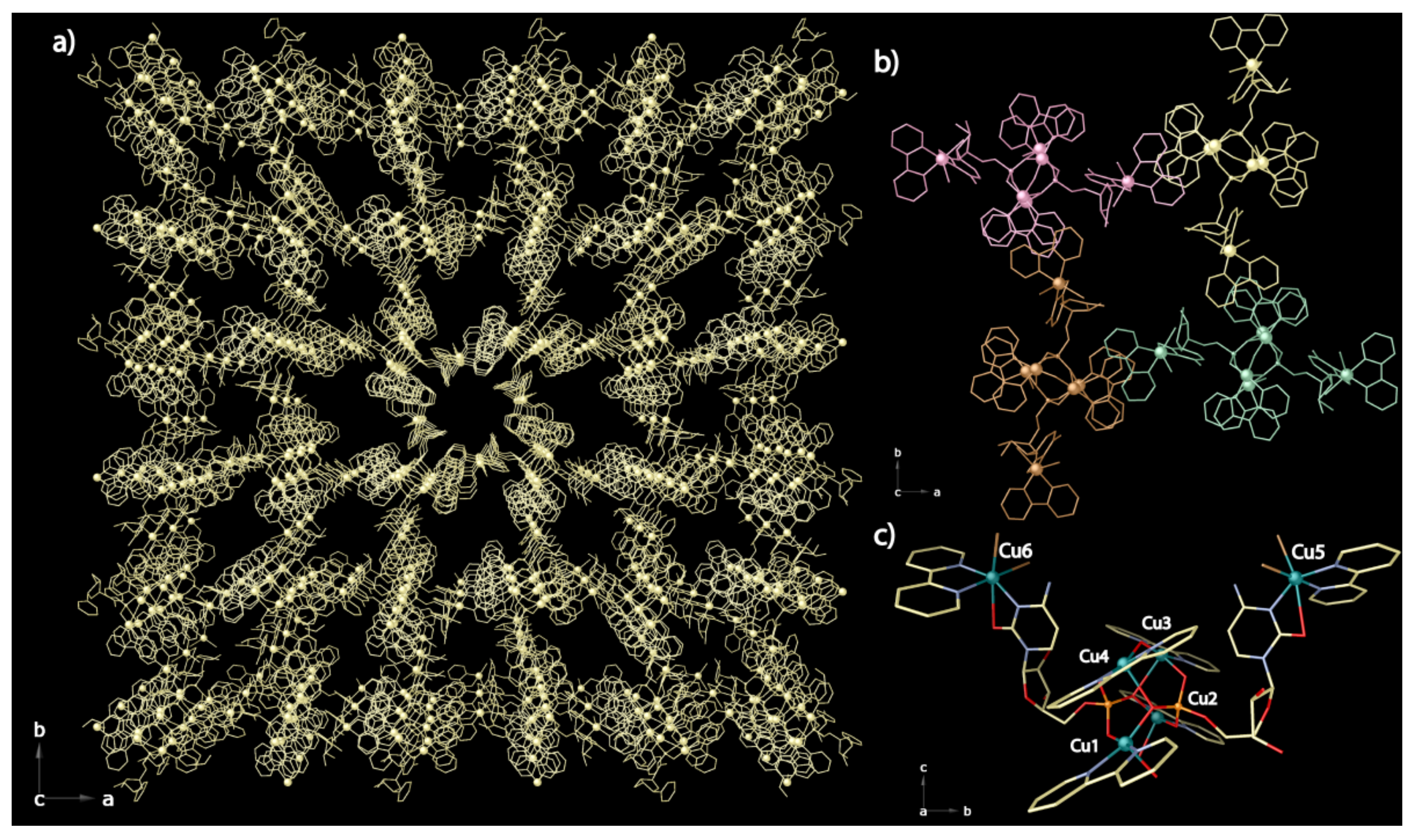

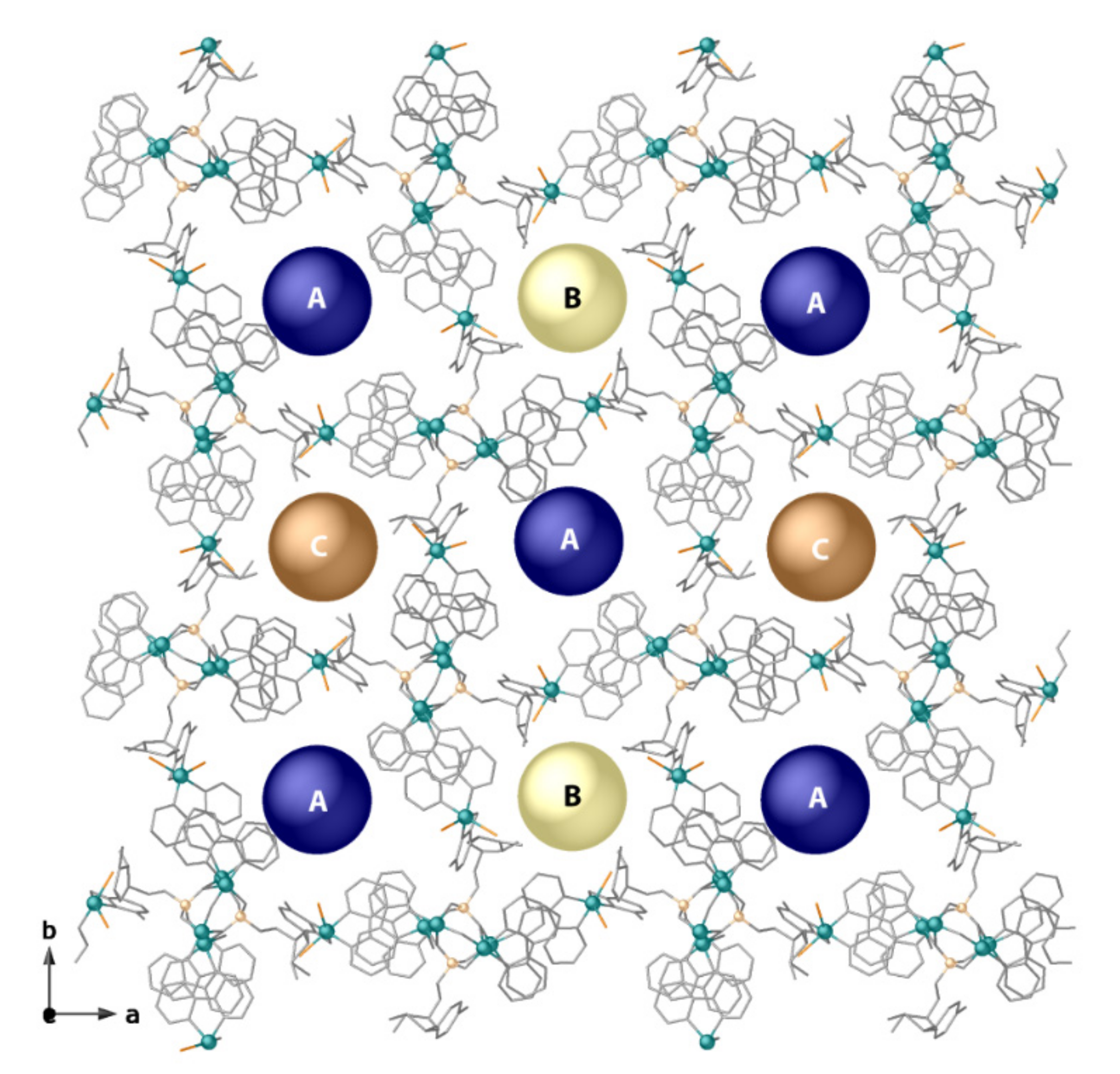
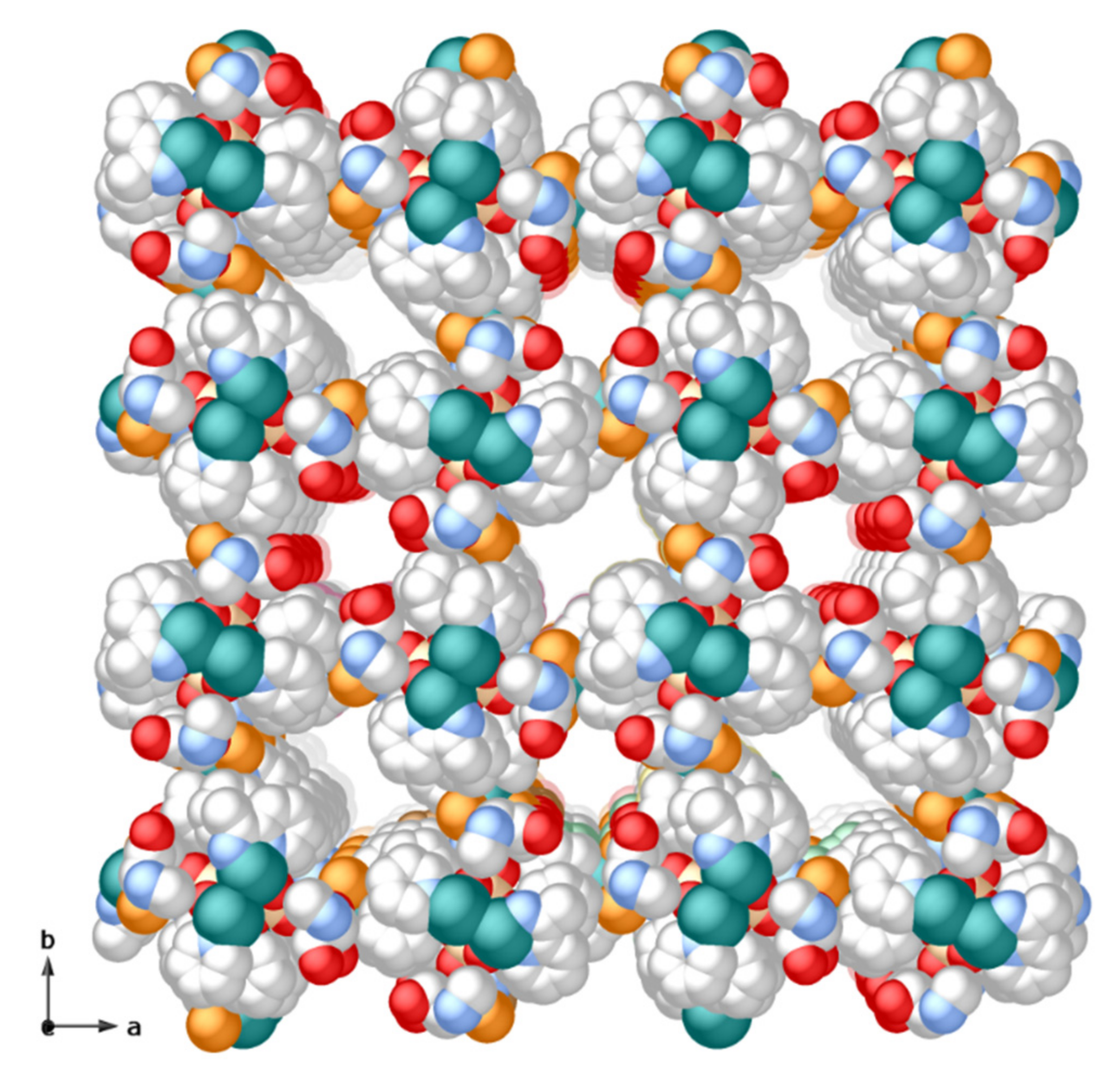
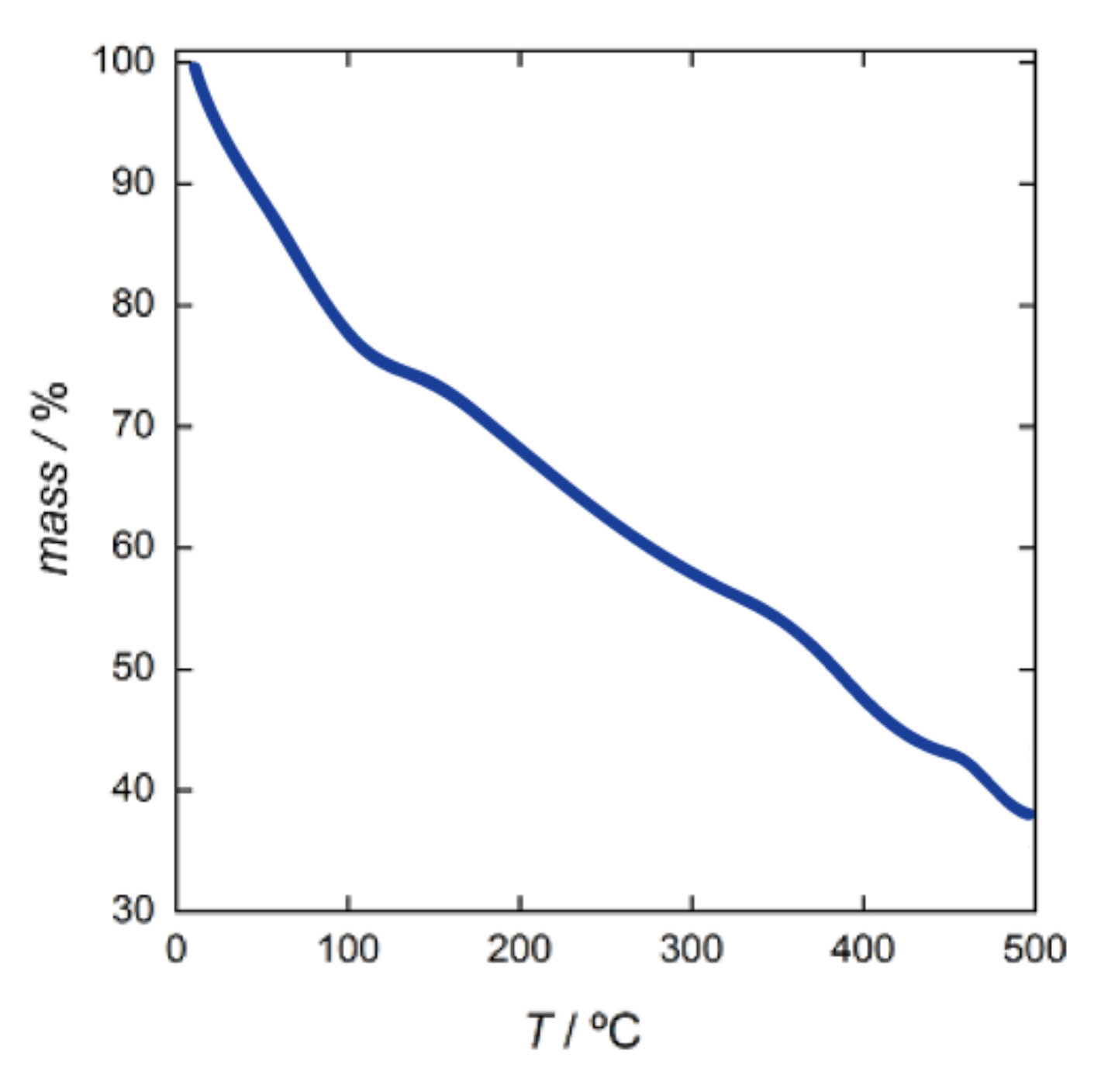
3. Materials and Methods
3.1. Synthesis of Compound CMP MOF 1
3.2. Thermogravimetric Analysis
3.3. X-ray Powder Diffraction
3.4. Single Crystal X-ray Diffraction
4. Conclusions
Supplementary Materials
Author Contributions
Funding
Institutional Review Board Statement
Informed Consent Statement
Data Availability Statement
Conflicts of Interest
Sample Availability
References
- Lehn, J.-M. Supramolecular Chemistry: Concepts and Perspectives; VCH Verlagsgesellschaft mbH: Weinheim, Germany, 1995. [Google Scholar]
- Lehn, J.-M. Supramolecular Chemistry—Scope and Perspectives Molecules, Supermolecules, and Molecular Devices (Nobel Lecture). Angew. Chem. Int. Ed. Engl. 1988, 27, 89–112. [Google Scholar] [CrossRef]
- Lehn, J.M. Perspectives in chemistry—Aspects of adaptive chemistry and materials. Angew. Chem. Int. Ed. 2015, 54, 3276–3289. [Google Scholar] [CrossRef] [PubMed]
- Jonathan, W.; Steed, J.L.A. Supramolecular Chemistry, 2nd ed.; Wiley-VCH: Weinheim, Germany, 2009. [Google Scholar]
- Webber, M.J.; Appel, E.A.; Meijer, E.W.; Langer, R. Supramolecular biomaterials. Nat. Mater. 2015, 15, 13–26. [Google Scholar] [CrossRef]
- Amabilino, D.B.; Smith, D.K.; Steed, J.W. Supramolecular materials. Chem. Soc. Rev. 2017, 46, 2404–2420. [Google Scholar] [CrossRef]
- Liu, J.; Li, X.; Yang, X.; Zhang, X. Recent Advances in Self-Healable Intelligent Materials Enabled by Supramolecular Crosslinking Design. Adv. Intell. Syst. 2021, 3, 2000183. [Google Scholar] [CrossRef]
- Rodell, C.B.; Mealy, J.E.; Burdick, J.A. Supramolecular Guest-Host Interactions for the Preparation of Biomedical Materials. Bioconjug. Chem. 2015, 26, 2279–2289. [Google Scholar] [CrossRef]
- Li, Z.; Liu, X.; Wang, G.; Li, B.; Chen, H.; Li, H.; Zhao, Y. Photoresponsive supramolecular coordination polyelectrolyte as smart anticounterfeiting inks. Nat. Commun. 2021, 12, 1–8. [Google Scholar]
- Tang, W.Q.; Zhao, Y.J.; Xu, M.; Xu, J.Y.; Meng, S.S.; Yin, Y.D.; Zhang, Q.H.; Gu, L.; Liu, D.H.; Gu, Z.Y. Controlling the Stacking Modes of Metal–Organic Framework Nanosheets through Host–Guest Noncovalent Interactions. Angew. Chemie Int. Ed. 2021, 60, 6920–6925. [Google Scholar] [CrossRef] [PubMed]
- Chen, T.; Xu, Y.; Peng, Z.; Li, A.; Liu, J. Simultaneous Enhancement of Bioactivity and Stability of Laccase by Cu2+/PAA/PPEGA Matrix for Efficient Biosensing and Recyclable Decontamination of Pyrocatechol. J. Anal. Chem. 2017, 89, 2065–2072. [Google Scholar] [CrossRef] [PubMed]
- Kong, N.; Gooding, J.J.; Liu, J.J. Protein sensors based on reversible π–π stacking on basal plane HOPG electrodes. Solid State Electrochem. 2014, 18, 3379–3386. [Google Scholar] [CrossRef]
- Cao, M.; Fu, A.; Wang, Z.; Liu, J.; Kong, N.; Zong, X.; Liu, H.; Gooding, J.J. Electrochemical and theoretical study of π-π Stacking interactions between graphitic surfaces and pyrene derivatives. J. Phys. Chem. C 2014, 118, 2650–2659. [Google Scholar] [CrossRef]
- Wendler, K.; Thar, J.; Zahn, S.; Kirchner, B.J. Estimating the hydrogen bond energy. Phys. Chem. A 2010, 114, 9529–9536. [Google Scholar] [CrossRef]
- Zhao, Y.; Truhlar, D.G.J. Density functionals for noncovalent interaction energies of biological importance. Chem. Theory Comput. 2007, 3, 289–300. [Google Scholar] [CrossRef]
- Wu, D.; Zhang, P.F.; Yang, G.P.; Hou, L.; Zhang, W.Y.; Han, Y.F.; Liu, P.; Wang, Y.Y. Supramolecular control of MOF pore properties for the tailored guest adsorption/separation applications. Coord. Chem. Rev. 2021, 434, 213709. [Google Scholar]
- Gupta, M.; Vittal, J.J. Control of interpenetration and structural transformations in the interpenetrated MOFs. Coord. Chem. Rev. 2021, 435, 213789. [Google Scholar] [CrossRef]
- Hosseini, M.W. Self-assembly and generation of complexity. Chem. Commun. 2005, 47, 5825–5829. [Google Scholar] [CrossRef] [PubMed]
- Lin, R.B.; He, Y.; Li, P.; Wang, H.; Zhou, W.; Chen, B. Multifunctional porous hydrogen-bonded organic framework materials. Chem. Soc. Rev. 2019, 48, 1362–1389. [Google Scholar] [CrossRef]
- Bao, Z.; Xie, D.; Chang, G.; Wu, H.; Li, L.; Zhou, W.; Wang, H.; Zhang, Z.; Xing, H.; Yang, Q.; et al. Fine Tuning and Specific Binding Sites with a Porous Hydrogen-Bonded Metal-Complex Framework for Gas Selective Separations. J. Am. Chem. Soc. 2018, 140, 4596–4603. [Google Scholar] [CrossRef] [PubMed] [Green Version]
- Luo, J.; Wang, J.W.; Zhang, J.H.; Lai, S.; Zhong, D.C. Hydrogen-bonded organic frameworks: Design, structures and potential applications. CrystEngComm 2018, 20, 5884–5898. [Google Scholar] [CrossRef]
- Hu, F.; Liu, C.; Wu, M.; Pang, J.; Jiang, F.; Yuan, D.; Hong, M. An Ultrastable and Easily Regenerated Hydrogen-Bonded Organic Molecular Framework with Permanent Porosity. Angew. Chem. Int. Ed. 2017, 56, 2101–2104. [Google Scholar] [CrossRef]
- Chae, H.K.; Siberio-Pérez, D.Y.; Kim, J.; Go, Y.; Eddaoudi, M.; Matzger, A.J.; O’Keeffe, M.; Yaghi, O.M. A route to high surface area, porosity and inclusion of large molecules in crystals. Nature 2004, 427, 523–527. [Google Scholar] [CrossRef] [PubMed]
- Schoedel, A.; Li, M.; Li, D.; O’Keeffe, M.; Yaghi, O.M. Structures of Metal-Organic Frameworks with Rod Secondary Building Units. Chem. Rev. 2016, 116, 12466–12535. [Google Scholar] [CrossRef] [PubMed]
- Furukawa, H.; Cordova, K.E.; O’Keeffe, M.; Yaghi, O.M. The chemistry and applications of metal-organic frameworks. Science 2013, 341, 1230444. [Google Scholar] [CrossRef] [PubMed] [Green Version]
- Decker, G.E.; Lorzing, G.R.; Deegan, M.M.; Bloch, E.D. MOF-mimetic molecules: Carboxylate-based supramolecular complexes as molecular metal-organic framework analogues. J. Mater. Chem. A 2020, 8, 4217–4229. [Google Scholar] [CrossRef]
- Halder, A.; Bhattacharya, B.; Haque, F.; Dinda, S.; Ghoshal, D. Polarity-Induced Excited-State Intramolecular Proton Transfer (ESIPT) in a Pair of Supramolecular Isomeric Multifunctional Dynamic Metal–Organic Frameworks. Chem. Eur. J. 2019, 25, 12196–12205. [Google Scholar] [CrossRef]
- Maurin, G.; Serre, C.; Cooper, A.; Férey, G. The new age of MOFs and of their porous-related solids. Chem. Soc. Rev. 2017, 46, 3104–3107. [Google Scholar] [CrossRef]
- Côté, A.P.; Benin, A.I.; Ockwig, N.W.; O’Keeffe, M.; Matzger, A.J.; Yaghi, O.M. Chemistry: Porous, crystalline, covalent organic frameworks. Science 2005, 310, 1166–1170. [Google Scholar] [CrossRef] [Green Version]
- Lin, S.; Diercks, C.S.; Zhang, Y.-B.; Kornienko, N.; Nichols, E.M.; Zhao, Y.; Paris, A.R.; Kim, D.; Yang, P.; Yaghi, O.M.; et al. Covalent organic frameworks comprising cobalt porphyrins for catalytic CO2 reduction in water. Science 2015, 349, 1208. [Google Scholar] [CrossRef] [Green Version]
- Yu, C.; Shao, Z.; Liu, L.; Hou, H. Efficient and Selective Removal of Copper(II) from Aqueous Solution by a Highly Stable Hydrogen-Bonded Metal-Organic Framework. Cryst. Growth Des. 2018, 18, 3082–3088. [Google Scholar] [CrossRef]
- Li, P.; Ryder, M.R.; Stoddart, J.F. Hydrogen-Bonded Organic Frameworks: A Rising Class of Porous Molecular Materials. Accounts Mater. Res. 2020, 1, 77–87. [Google Scholar] [CrossRef]
- Wang, B.; Lin, R.B.; Zhang, Z.; Xiang, S.; Chen, B.J. Hydrogen-Bonded Organic Frameworks as a Tunable Platform for Functional Materials. Am. Chem. Soc. 2020, 142, 14399–14416. [Google Scholar] [CrossRef]
- Chong, J.H.; Ardakani, S.J.; Smith, K.J.; MacLachlan, M.J. Triptycene-based metal salphens-exploiting intrinsic molecular porosity for gas storage. Chem. Eur. J. 2009, 15, 11824–11828. [Google Scholar] [CrossRef]
- Suh, K.; Yutkin, M.P.; Dybtsev, D.N.; Fedin, V.P.; Kim, K. Enantioselective sorption of alcohols in a homochiral metal–organic framework. Chem. Commun. 2012, 48, 513–515. [Google Scholar] [CrossRef] [PubMed] [Green Version]
- Guo, J.; Xu, Y.; Jin, S.; Chen, L.; Kaji, T.; Honsho, Y.; Addicoat, M.A.; Kim, J.; Saeki, A.; Ihee, H.; et al. Conjugated organic framework with three-dimensionally ordered stable structure and delocalized π clouds. Nat. Commun. 2013, 4, 2726. [Google Scholar] [CrossRef] [Green Version]
- Fukunaga, H.; Miyasaka, H. Magnet design by integration of layer and chain magnetic systems in a π-stacked pillared layer framework. Angew. Chem. Int. Ed. 2015, 54, 569–573. [Google Scholar] [CrossRef]
- Deng, J.H.; Luo, J.; Mao, Y.L.; Lai, S.; Gong, Y.N.; Zhong, D.C.; Lu, T.B. π-π stacking interactions: Non-negligible forces for stabilizing porous supramolecular frameworks. Sci. Adv. 2020, 6, 1–9. [Google Scholar] [CrossRef] [Green Version]
- Wei, P.; He, X.; Zheng, Z.; He, D.; Li, Q.; Gong, J.; Zhang, J.; Sung, H.H.Y.; Williams, I.D.; Lam, J.W.Y.; et al. Robust Supramolecular Nano-Tunnels Built from Molecular Bricks. Angew. Chem. Int. Ed. 2021, 60, 7148–7154. [Google Scholar] [CrossRef]
- He, Y.; Lopez, A.; Zhang, Z.; Chen, D.; Yang, R.; Liu, J. Nucleotide and DNA coordinated lanthanides: From fundamentals to applications. Coord. Chem. Rev. 2019, 387, 235–248. [Google Scholar] [CrossRef]
- Morikawa, M.A.; Yoshihara, M.; Endo, T.; Kimizuka, N.J. ATP as building blocks for the self-assembly of excitonic nanowires. Am. Chem. Soc. 2005, 127, 1358–1359. [Google Scholar] [CrossRef] [PubMed]
- Qiu, Q.M.; Zhou, P.; Gu, L.; Hao, L.; Liu, M.; Li, H. Cytosine–Cytosine Base-Pair Mismatch and Chirality in Nucleotide Supramolecular Coordination Complexes. Chem. Eur. J. 2017, 23, 7201–7206. [Google Scholar] [CrossRef] [PubMed]
- Pu, F.; Ren, J.; Qu, X. Nucleobases, nucleosides, and nucleotides: Versatile biomolecules for generating functional nanomaterials. Chem. Soc. Rev. 2018, 47, 1285–1306. [Google Scholar] [CrossRef] [PubMed]
- Pu, F.; Huang, Y.; Yang, Z.; Qiu, H.; Ren, J. Nucleotide-Based Assemblies for Green Synthesis of Silver Nanoparticles with Controlled Localized Surface Plasmon Resonances and Their Applications. ACS Appl. Mater. Interfaces 2018, 10, 9929–9937. [Google Scholar] [CrossRef] [PubMed]
- Xu, L.; Zhang, P.; Liu, Y.; Fang, X.; Zhang, Z.; Liu, Y.; Peng, L.; Liu, J. Continuously Tunable Nucleotide/Lanthanide Coordination Nanoparticles for DNA Adsorption and Sensing. ACS Omega 2018, 3, 9043–9051. [Google Scholar] [CrossRef]
- Nayak, A.K.; Subudhi, U. Directed self-assembly of genomic sequences into monomeric and polymeric branched DNA structures. RSC Adv. 2014, 4, 54506–54511. [Google Scholar] [CrossRef]
- Wang, F.; Liu, X.; Willner, I. DNA switches: From principles to applications. Angew. Chem. Int. Ed. 2015, 54, 1098–1129. [Google Scholar] [CrossRef] [PubMed]
- Liu, J.; Yuan, X.X.; Li, H.W.; Wu, Y. Hydrothermal synthesis of novel photosensitive gold and silver bimetallic nanoclusters protected by adenosine monophosphate (AMP). J. Mater. Chem. C 2017, 5, 9979–9985. [Google Scholar] [CrossRef]
- Song, W.J.; Su, H.; Zhou, P.; Zhu, Y.H.; Khan, M.A.; Song, J.B.; Li, H. Controllable synthesis of two adenosine 5′-monophosphate nucleotide coordination polymersviapH regulation: Crystal structure and chirality. Dalt. Trans. 2021, 50, 4713–4719. [Google Scholar] [CrossRef]
- Du, Z.; Hu, Y.; Wang, P.; Zhou, J.; Xiong, J.; Ying, H.; Bai, J. Conformers and hydrogen bonds in cytidine 5′-diphosphocholine sodium single crystals grown from a mixture of ethanol and water. J. Mol. Struct. 2011, 985, 227–232. [Google Scholar] [CrossRef]
- Armentano, D.; Mastropietro, T.F.; Julve, M.; Rossi, R.; Rossi, P.; De Munno, G. A new octanuclear copper(II)-nucleoside wheel. J. Am. Chem. Soc. 2007, 129, 2740–2741. [Google Scholar] [CrossRef]
- Marino, N.; Armentano, D.; Pardo, E.; Vallejo, J.; Neve, F.; Di Donna, L.; De Munno, G. Homochiral self-assembly of biocoordination polymers: Anion-triggered helicity and absolute configuration inversion. Chem. Sci. 2015, 6, 4300–4305. [Google Scholar] [CrossRef] [Green Version]
- Bruno, R.; Mastropietro, T.F.; De Munno, G.; Pardo, E.; Armentano, D. Synthesis of a rod-based porous coordination polymer from a nucleotide as a sequential chiral inductor. J. Coord. Chem. 2021, 74, 200–215. [Google Scholar] [CrossRef]
- Santra, B.; Kalita, P.; Chandra, S.; Mandal, D.; Kumar, V.; Narayanan, R.S.; Dey, A.; Chrysochos, N.; Huch, V.; Biswas, S.; et al. Molecular enneanuclear CuII phosphates containing planar hexanuclear and trinuclear sub-units: Syntheses, structures, and magnetism. Dalt. Trans. 2020, 49, 2527–2536. [Google Scholar] [CrossRef]
- Zhou, P.; Yao, J.F.; Sheng, C.F.; Li, H. A continuing tale of chirality: Metal coordination extended axial chirality of 4,4’-bipy to 1D infinite chain under cooperation of a nucleotide ligand. CrystEngComm 2013, 15, 8430–8436. [Google Scholar] [CrossRef]
- Terrón, A.; Tomàs, L.; Bauzá, A.; García-Raso, A.; Fiol, J.J.; Molins, E.; Frontera, A. The first X-ray structure of a silver-nucleotide complex: Interaction of ion Ag(i) with cytidine-5′-monophosphate. CrystEngComm 2017, 19, 5830–5834. [Google Scholar] [CrossRef]
- Zhou, P.; Wang, C.; Qiu, Q.M.; Yao, J.F.; Sheng, C.F.; Li, H. Controllable synthesis of nucleotide complex based on pH control: A small-molecule fluorescent probe as an auxiliary ligand to indicate the pre-organization of the nucleotide complex in solution. Dalt. Trans. 2015, 44, 17810–17818. [Google Scholar] [CrossRef] [PubMed]
- Chu, Y.; Hou, J.; Boyer, C.; Richardson, J.J.; Liang, K.; Xu, J. Biomimetic synthesis of coordination network materials: Recent advances in MOFs and MPNs. J. Appl. Mater. Today 2018, 10, 93–105. [Google Scholar] [CrossRef]
- Xue, M.; Li, B.; Qiu, S.; Chen, B. Emerging functional chiral microporous materials: Synthetic strategies and enantioselective separations. Mater. Today 2016, 19, 503–515. [Google Scholar] [CrossRef]
- Willner, I. Biomaterials for Sensors, Fuel Cells, and Circuitry. Science 2002, 298, 2407–2408. [Google Scholar] [CrossRef] [PubMed]
- Aoki, K. X-ray Crystal Structure of the 1: 1 Manganese-Cytosine 5’-Phosphate Complex: Metal Bonding to Both O(2) of the Base and Phosphate. J. Chem. Soc. Chem. Commun. 1976, 44, 748–749. [Google Scholar] [CrossRef]
- Aoki, K.J. X-ray Crystal Structures of the Ternary Complexes [Cd(5’-UMP)(dpa)(H20)& (5’ -UMP = uridine 5’-phosphate,:dpa=2,2’ -dipyridylamine): Metal Ion Bridged Stacking between Nucleotide Bases and Aromatic Ainine Rings, and [Cu(5’-CMP)(dpa)(H20)1, (5’-CMP=cytidine 5’-phosphate): Phosphate Only Metal Bonding. J. Chem. Soc. Chem. Commun. 1979, 625, 589–591. [Google Scholar]
- Clark, G.R.C.; Orbell, J.D. Transit ion-metal-Nucleo tide Complexes. X- Ray Crystal and Molecular Structure of the Complex Between Nicke(lI) and Inosine 5’-Monophosphate [Ni(imp)(H2O)2H2O. J. Chem. Soc. Chem. Commun. 1974, 139–140. [Google Scholar] [CrossRef]
- Miller, S.K.; VanDerveer, D.G.; Marzilli, L.G. Models for the interaction of zinc(2+) ion with DNA. The synthesis and x-ray structural characterization of two octahedral zinc complexes with monomethyl phosphate esters of 6-oxopurine 5’-monophosphate nucleotides. J. Am. Chem. Soc. 1985, 107, 1048–1055. [Google Scholar] [CrossRef]
- Ji, L.; Le, X. Stacking interaction in metal complexes with compositions of DNA and heteroaromatic N-bases. Chin. Sci. Bull. 2002, 47, 1–9. [Google Scholar] [CrossRef]
- Sigel, H. Interactions of Metal Ions w i t h Nucleotides and Nucleic Acids and their Constituents. Chem. Soc. Rev. 1993, 22, 255–267. [Google Scholar] [CrossRef]
- Zhou, P.; Shi, R.; Yao, J.F.; Sheng, C.F.; Li, H. Supramolecular self-assembly of nucleotide-metal coordination complexes: From simple molecules to nanomaterials. Coord. Chem. Rev. 2015, 292, 107–143. [Google Scholar] [CrossRef]
- Forgan, R.S. Modulated self-assembly of metal-organic frameworks. Chem. Sci. 2020, 11, 4546–4562. [Google Scholar] [CrossRef] [PubMed] [Green Version]
- Armentano, D.; Marino, N.; Mastropietro, T.F.; Martínez-Lillo, J.; Cano, J.; Julve, M.; Lloret, F.; De Munno, G. Self-assembly of a chiral carbonate- and cytidine-containing dodecanuclear copper(II) complex: A multiarm-supplied globular capsule. Inorg. Chem. 2008, 47, 10229–10231. [Google Scholar] [CrossRef] [PubMed]
- Marino, N.; Armentano, D.; Mastropietro, T.F.; Julve, M.; Lloret, F.; De Munno, G. A Copper(II)-Cytidine Complex as a Building Unit for the Construction of an Unusual Three-Dimensional Coordination Polymer. Cryst. Growth Des. 2010, 10, 1757–1761. [Google Scholar] [CrossRef]
- Marino, N.; Armentano, D.; Zanchini, C.; De Munno, G. Ca2+ metal ion adducts with cytosine, cytidine and cytidine 5′-monophosphate: A comprehensive study of calcium reactivity towards building units of nucleic acids. CrystEngComm 2014, 16, 8286–8296. [Google Scholar] [CrossRef]
- Bruno, R.; Marino, N.; Bartella, L.; Di Donna, L.; De Munno, G.; Pardo, E.; Armentano, D. Highly efficient temperature-dependent chiral separation with a nucleotide-based coordination polymer. Chem. Commun. 2018, 54, 6356–6359. [Google Scholar] [CrossRef] [PubMed]
- Koval, I.A.; Schuitema, A.M.; Driessen, W.L.; Reedijk, J. Unprecedented copper(II)-assisted acetal formation of a formyl-substituted bispyrazole. The X-ray structures of copper[1,2-bis- (3′-dimethoxymethylpyrazol-1′-yl)ethane] dichloride and dibromide. J. Chem. Soc. Dalt. Trans. 2001, 3663–3667. [Google Scholar]
- Blatov, V.A.; Shevchenko, A.P.; Proserpio, D.M. Applied Topological Analysis of Crystal Structures with the Program Package ToposPro. Cryst. Growth Des. 2014, 14, 3576–3586. [Google Scholar] [CrossRef]
- Alexandrov, E.V.; Blatov, V.A.; Kochetkov, A.V.; Proserpio, D.M. Underlying nets in three-periodic coordination polymers: Topology, taxonomy and prediction from a computer-aided analysis of the Cambridge Structural Database. CrystEngComm 2011, 13, 3947–3958. [Google Scholar] [CrossRef]
- Sheldrick, G.M. SADABS Program for Absorption Correction, Version 2.10; Analytical X-ray Systems: Madison, WI, USA, 1998. [Google Scholar]
- Sheldrick, G.M. A short history of SHELX. Acta Crystallogr. Sect. A Found. Crystallogr. 2008, 64, 112–122. [Google Scholar] [CrossRef] [PubMed] [Green Version]
- Sheldrick, G.M. Crystal structure refinement with SHELXL. Acta Crystallogr. Sect. C Struct. Chem. 2015, 71, 3–8. [Google Scholar] [CrossRef]
- Farrugia, L.J. WinGX suite for small-molecule single-crystal crystallography. J. Appl. Crystallogr. 1999, 32, 837–838. [Google Scholar] [CrossRef]
- Farrugia, L.J. WinGX and ORTEP for Windows: An update. J. Appl. Crystallogr. 2012, 45, 849–854. [Google Scholar] [CrossRef]
- Palmer, D. Visualization and analysis of crystal structures using CrystalMaker software. Z. Krist. Cryst. Mater. 2015, 230, 559–572. [Google Scholar] [CrossRef]
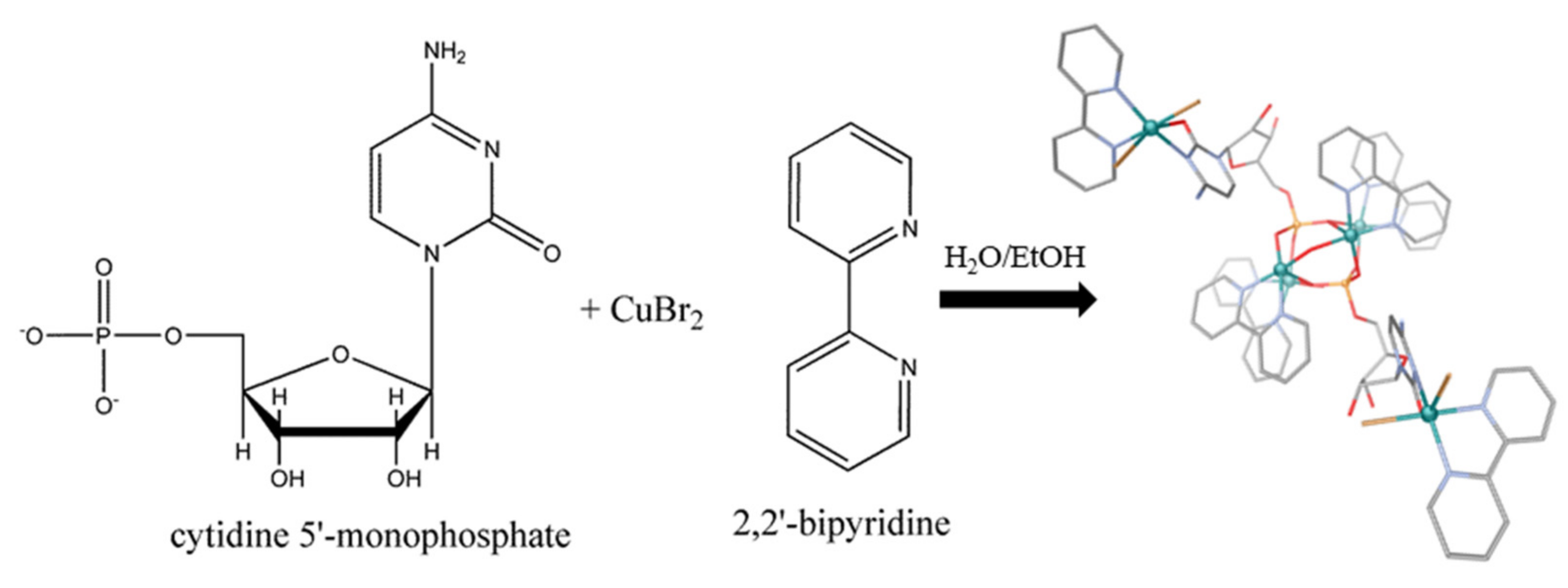
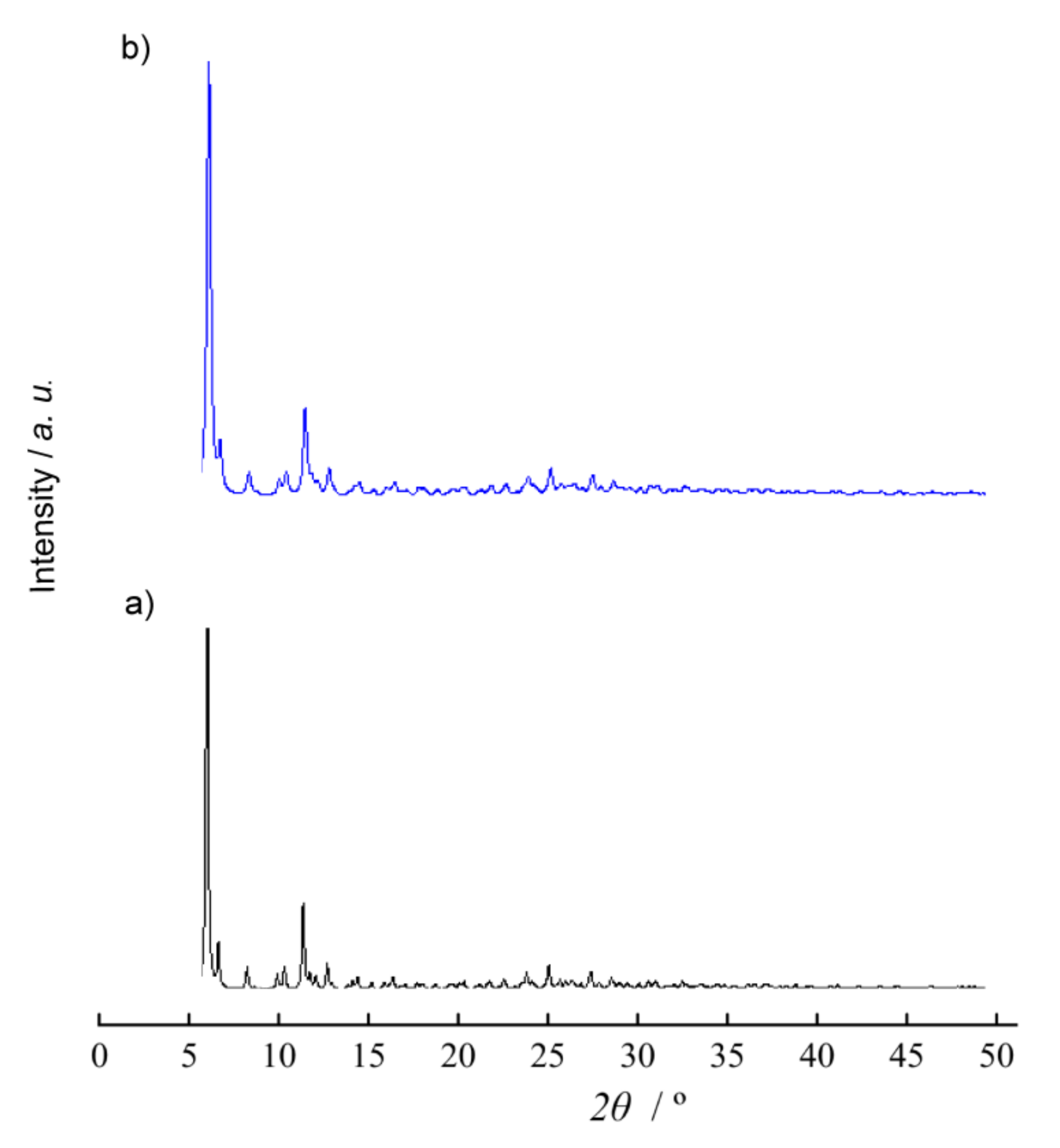
Publisher’s Note: MDPI stays neutral with regard to jurisdictional claims in published maps and institutional affiliations. |
© 2021 by the authors. Licensee MDPI, Basel, Switzerland. This article is an open access article distributed under the terms and conditions of the Creative Commons Attribution (CC BY) license (https://creativecommons.org/licenses/by/4.0/).
Share and Cite
Bruno, R.; Mastropietro, T.F.; De Munno, G.; Armentano, D. A Nanoporous Supramolecular Metal–Organic Framework Based on a Nucleotide: Interplay of the π···π Interactions Directing Assembly and Geometric Matching of Aromatic Tails. Molecules 2021, 26, 4594. https://doi.org/10.3390/molecules26154594
Bruno R, Mastropietro TF, De Munno G, Armentano D. A Nanoporous Supramolecular Metal–Organic Framework Based on a Nucleotide: Interplay of the π···π Interactions Directing Assembly and Geometric Matching of Aromatic Tails. Molecules. 2021; 26(15):4594. https://doi.org/10.3390/molecules26154594
Chicago/Turabian StyleBruno, Rosaria, Teresa F. Mastropietro, Giovanni De Munno, and Donatella Armentano. 2021. "A Nanoporous Supramolecular Metal–Organic Framework Based on a Nucleotide: Interplay of the π···π Interactions Directing Assembly and Geometric Matching of Aromatic Tails" Molecules 26, no. 15: 4594. https://doi.org/10.3390/molecules26154594
APA StyleBruno, R., Mastropietro, T. F., De Munno, G., & Armentano, D. (2021). A Nanoporous Supramolecular Metal–Organic Framework Based on a Nucleotide: Interplay of the π···π Interactions Directing Assembly and Geometric Matching of Aromatic Tails. Molecules, 26(15), 4594. https://doi.org/10.3390/molecules26154594






